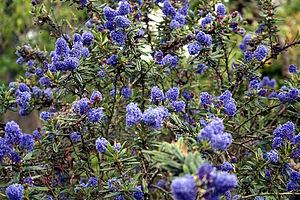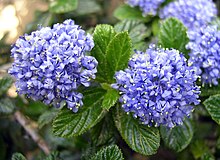Californian lilac
| Californian lilac | ||||||||||||
|---|---|---|---|---|---|---|---|---|---|---|---|---|

California lilac ( Ceanothus thyrsiflorus ) |
||||||||||||
| Systematics | ||||||||||||
|
||||||||||||
| Scientific name | ||||||||||||
| Ceanothus thyrsiflorus | ||||||||||||
| Eschsch. |
The California lilac ( Ceanothus thyrsiflorus ) is a plant from the genus of ceanothus ( Ceanothus ) within the family of Buckthorn family (Rhamnaceae). The natural range of the species is in California.
description
The Californian lilac grows as a shrub with heights of up to 12 meters and a diameter of 0.25 to 0.28 meters. In locations exposed to the wind, the Californian lilac is only 0.3 to 0.6 meters high, but still flowers and produces fruit. It divides into several trunks at a height of 1.5 to 2.0 meters. The bark is thin with a red-brown surface that is layered in scales. The flowering time is in spring . Many flowers stand together in truss- shaped inflorescences . The fragrant flowers are five-fold with a double flower envelope . The five petals are blue or white.
ecology
Like all ceanothus species of California lilac lives in symbiosis with air nitrogen-fixing Frankia bacteria, which as actinorhizal plant is called.
Occurrence
The Californian lilac is found on shady hills, forest edges or streams in Western California . The largest specimens thrive in the regions of the coastal redwood ( Sequoia sempervirens ), often together with the Douglas fir ( Pseudotsuga menziesii ), willow ( Salix ) and oak species ( Quercus ).
discovery
Ceanothus thyrsiflorus was discovered in 1816 by Johann Friedrich Eschscholtz during the circumnavigation of the Rurik expedition .
Systematics
The first description of Ceanothus thyrsiflorus was in 1826 by Johann Friedrich Eschscholtz in Mémoires de l'Académie Imperiale des Sciences de St. Pétersbourg. Avec l'Histoire de l'Académie , Volume 10, 2, p. 285, there under the name "thyrsiflora".
Of Ceanothus thyrsiflorus there are two varieties:
- Ceanothus thyrsiflorus var. Repens McMinn
- Ceanothus thyrsiflorus Eschsch. var. thyrsiflorus
use
The wood is quite soft with light brown heartwood and thin, darker sapwood . California lilac was introduced to the UK as an ornamental plant in 1837 , but was soon replaced by other hybrids .
Others
Salicylic acid methyl ester (wintergreen oil) can be extracted from the young leaves by squeezing them .
Individual evidence
- ↑ a b c d e Klaus Ulrich Leistikow: The Woodbook: The Complete Plates . TASCHEN Verlag, Cologne 2013, ISBN 978-3-8365-3603-5 , pp. 138 .
- ^ Brian Oakley, Malcolm North, Jerry F. Franklin, Brian P. Hedlund & James T. Staley: Diversity and Distribution of Frankia Strains Symbiotic with Ceanothus in California. In: Applied and Environmental Microbiology , Volume 70, 2004, pp. 6444-6452. doi : 10.1128 / AEM.70.11.6444-6452.2004 .
- ↑ Ceanothus thyrsiflorus at Tropicos.org. Missouri Botanical Garden, St. Louis, accessed January 10, 2014.
- ↑ Ceanothus thyrsiflorus in the Germplasm Resources Information Network (GRIN), USDA , ARS , National Genetic Resources Program. National Germplasm Resources Laboratory, Beltsville, Maryland. Retrieved January 10, 2014.
- ↑ R. Hegnauer: Chemotaxonomy of plants. An overview of the distribution and the systematic importance of plant substances. Volume 6: Dicotyledoneae: Rafflesiaceae – Zygophyllaceae (= chemical series ). Birkhäuser Verlag, Basel 1973, ISBN 3-7643-0667-X , p. 61 .

